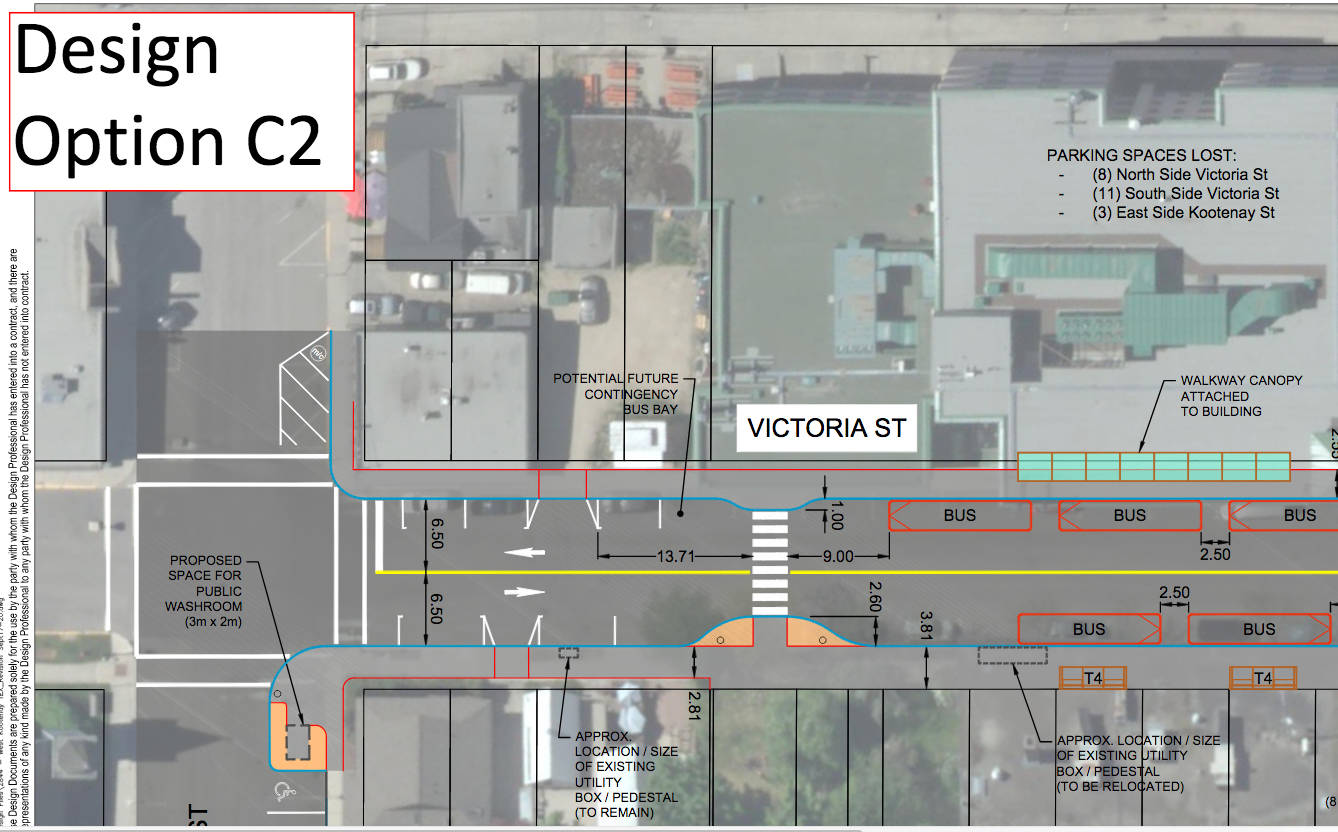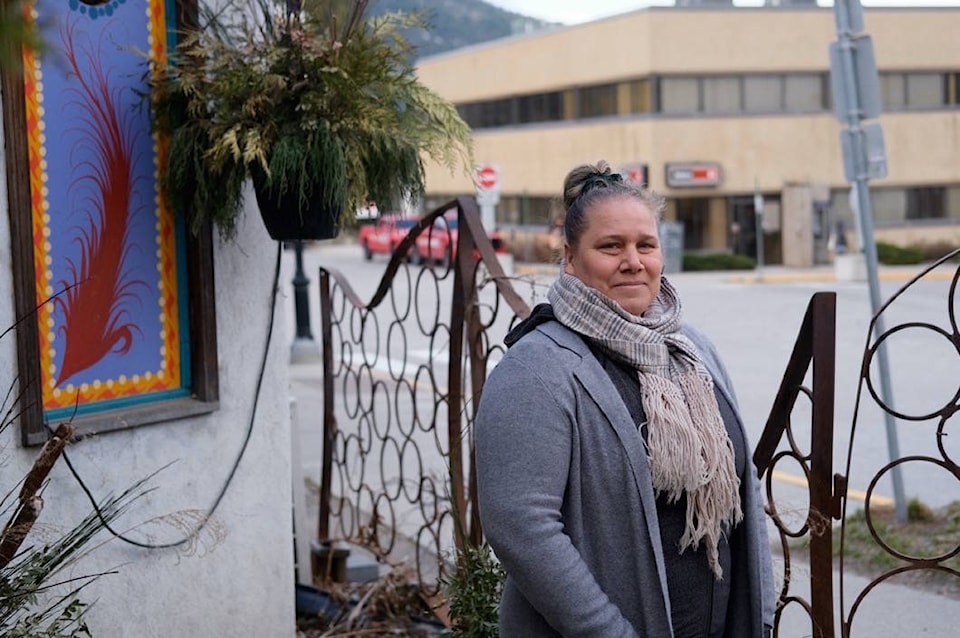Nelson City Council and BC Transit have identified three options for the design of a transit hub that will take up the entire 300 block of Victoria Street.
The decision, to be made at a council meeting on April 13, will not be about the location of the transit hub – that has already been decided – but rather which of the proposed designs to choose.
The 300 block of Victoria Street was recommended as a bus hub in the city’s Downtown Urban Design Strategy, published in 2017 by the previous council after a variety of public input, workshops, presentations and comment periods.
City planners and BC Transit say they chose the 300 block Victoria because it is the most feasible one for an upgraded downtown transit hub in a upcoming era of more transit and fewer cars.
But many businesses and residents on or near the 300 block are not happy about this.
Their concerns include congestion, a planned public washroom, the city’s decision-making process, and reduced parking and loading zones.
“This is my loading zone here, this white line,” says owner Justine Langevin on the sidewalk outside El Taco. “It’s used all day long – by all the businesses, by customers who just pull in, grab a slice of pizza (from Thor’s Pizza across the street) or to grab a burrito and leave.”
The proposed bus hub would eliminate most parking and all loading zones on the block, although the city says those parking spots would be replaced by new angled parking spaces opened up on Ward Street with the removal of the current bus hub.
“If we did a time lapse of a day in the lower Victoria Street corner here,” Langevin says, “it’s busy, there is a lot of action going on here. People coming and going, the three restaurants, the clinics (Kootenay Health Services and the Kootenay Medical Centre, both on Kootenay Street at the Victoria Street intersection). To change that flow would really impact us.”
Langevin also questions the way council and BC Transit approached public engagement.
According to BC Transit’s James Wadsworth, presenting at a city council meeting on March 23, local businesses and residents were asked over the past few months which of the three design options they preferred, through direct mail to affected people, social media, online advertising, a meeting with the Chamber of Commerce, a public survey that got 145 responses including 23 letters from the public, and a stakeholder meeting on Zoom on Jan. 20 attended by six people.
“We had a good conversation with them,” said Wadsworth. “Sometimes it is good to meet with people to discuss what is important to them and what is not.”
Langevin says that consultation was too little too late, and she feels she was not consulted before the city chose the 300 block in 2019.
Shifting away from cars
Councillor Rik Logtenberg, who is the council representative on the regional transit commission, says the purpose of the transit hub is to make transit more attractive and convenient.
“We need to shift away from the car as much as we can,” he told the Nelson Star. “We want to see people of all economic backgrounds riding transit, and the key driver for people to use transit is convenience.”
He said he expects that over time, with increasing numbers of buses, there will be more economic activity in that block, not less, driven by college students and the new apartments under construction on Falls Street.
Logtenberg said having the connector to the Castlegar campus of Selkirk College at the transit hub will mean El Taco and Thor’s will attract student customers.
According to BC Transit, there are plans to increase the number of buses in and out of Nelson over the next few years – the transit hub has space for five buses at a time – including many from outlying areas and the 99 route to Selkirk College in Castlegar.
Langevin’s concerns about the process are shared by Craig Sully of Kootenay Health Services at 602 Kootenay St.
“The first time we got a chance to even know that this was in the works was around Christmas in the middle of a pandemic,” he says. “The first time we saw drawings was at a Zoom meeting, where there were six people. And they asked us which option we would pick.”
Sully is also concerned about lack of parking and increased congestion.

Sully says it doesn’t make sense to bring buses into the downtown with passengers not necessarily going downtown or who might simply be transferring to another bus. He says this will create too much congestion and that some of this activity should happen in Railtown, with a trolley to downtown rather than “gigantic diesel buses, trying to make it through town in the middle of winter.”
Sully doesn’t buy Logtenberg’s analysis of the need for the hub.
“I think that he’s lost, or never had, a knowledge that his role as a council member is to actually listen to what the community has to say and represent the community. And it’s great that he’s got his own agenda for what everyone’s going to do.”
Transit costs in B.C. are usually split 50-50 between BC Transit and municipal governments. In this case, because of the likelihood of a federal grant, the split would be different, and the city would end up paying 20 per cent, or $35,000 to $70,000, depending on the design option chosen, said Wadsworth at the council meeting.

The three options
Wadsworth said all three design options include a number of things that urban transit designers consider essential in a transit hub:
• Space for at least five standard-sized buses
• A downtown location
• Shelters, benches, bike racks, and landscaping
• A public washroom
• Electronic next-bus schedule displays
• Alignment with CPTED (Crime Prevention Through Environmental Design) standards
The three options are:
Option A – preferred by 35.8 per cent of respondents in the public survey.
Victoria Street would be one-way with five bus stops, 11 parking stalls, and all bus traffic on one side of the street.
Option C1 – preferred by 3.5 per cent.
Victoria Street would be two-way, with seven bus stops, three parking stalls.
Option C2 – preferred by 28.3 per cent.
Victoria Street would be two-way, with five or six bus stops and five parking stalls.
In the survey results, 32.4 per cent chose “unsure/none.”

Public washrooms
Many of the letters from residents and visitors objected to the planned location of a public washroom as part of the transit hub, concerned that it will attract “the street crowd” as one business owner expressed it in a letter to council.
“I am concerned with the letters,” said Councillor Cal Renwick at the March 23 meeting. “The washroom, that is a big one for a lot of people, a lot of them don’t want that in that block at all.”
Logtenberg said a transit hub needs a public washroom and it is simply a question of where.
“We understand the concern, and are trying to figure that out,” he said. “No matter how rich or poor you are, you should be riding transit whenever you can. And that’s how we’re going to base policy. We’re going to assume that it’s a broad representation of the community … and it’s going to take time.”
City financial officer Colin McClure said a washroom at this location would not necessarily mirror the social scene at the washroom at Hall and Baker.
“I respect that there are some challenges at the Baker and Hall washroom, but … this one is a bit more out in the open, and being close to the police station would be a deterrent, and we can light it to make it as safe and friendly as possible.”
Mayor John Dooley reminded council that more bus traffic is expected from outlying areas in the coming years with additional routes from Salmo, the North Shore, Trail, Castlegar and Slocan.
”In Vancouver, a lot of businesses have set up shop at the end of a rapid transit line so they can capture that traffic when they get off the (train),” he said, “so there are developments built at the end of transit lines and hopefully people will be able to see the opportunity that is there.
“Having said that, this will come back to council in April and potentially be modified.”
Related:
• Nelson’s transit hub will move to 300 block Victoria
• Nelson developing downtown strategy
• Downtown redesign goes public
• Missing the Bus: Transit planners trying to fix overcrowding
• Missing the bus: Frustrations rise over crowded West Kootenay transit
bill.metcalfe@nelsonstar.com
Like us on Facebook and follow us on Twitter
